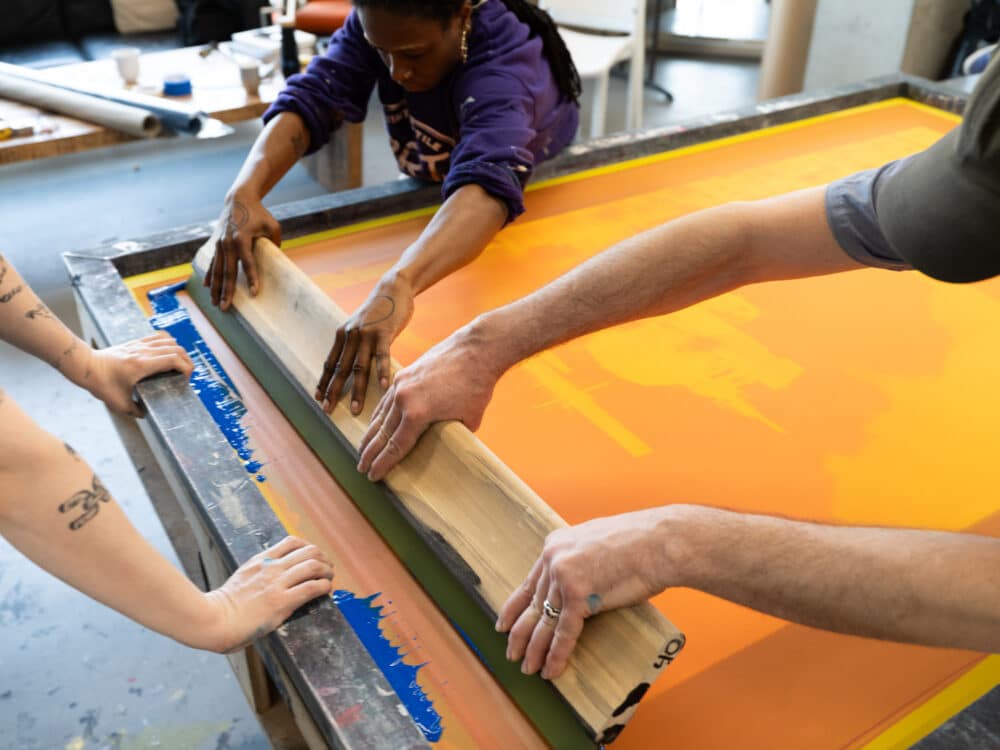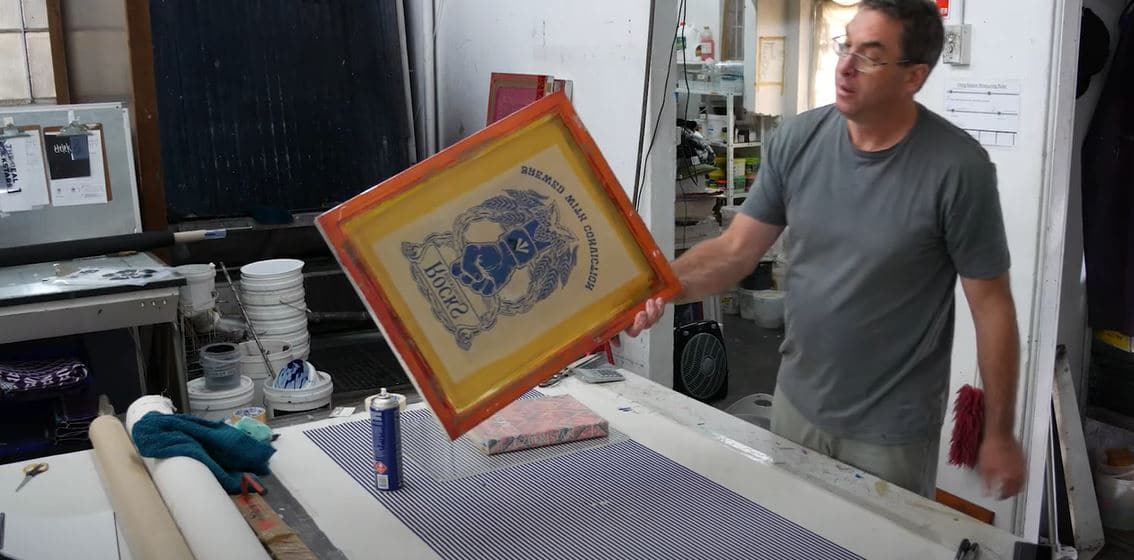ChatGPT said: Why 10:9 Design Screen Printing is perfect for custom t-shirts
Discover the Various Types of Screen Printing Techniques for Your Next Project
Screen printing offers a varied variety of methods that can enhance any kind of imaginative job. From typical techniques like serigraphy to contemporary developments such as direct-to-garment printing, each strategy has its unique advantages. Specialty alternatives, consisting of metallic and environmentally friendly inks, present also extra opportunities. Recognizing these techniques can considerably impact the final result. The difficulty lies in picking the most appropriate method for specific demands and preferred results. What elements should one take into consideration?

The Essentials of Screen Printing
Screen printing may seem complicated, it is basically a straightforward process that includes transferring ink with a mesh screen onto different surfaces. The method starts with the production of a pattern, which specifies the design to be published. This pattern is connected to a mesh screen, usually made of polyester or nylon. When the pattern is in location, ink is put on the screen and pushed through the mesh making use of a squeegee, resulting in the wanted pattern being printed on the underlying product.
Screen printing can be carried out on a large range of substratums, consisting of material, paper, and plastic, making it a flexible selection for various jobs. The procedure permits complex designs and vivid shades, making it prominent in sectors such as fashion, advertising and marketing, and art. Understanding these fundamentals gears up individuals with the fundamental knowledge required to discover advanced methods in screen printing.
Traditional Screen Printing Techniques
Conventional screen printing methods have actually been employed for centuries, maintaining the workmanship and artistry of this technique. This technique uses a mesh screen to transfer ink onto a substrate, such as fabric or paper, enabling for resilient and vivid layouts. The process begins with producing a stencil, which obstructs specific locations of the screen to control where the ink will certainly be applied.
One prominent technique is serigraphy, frequently utilized for minimal editions and imaginative prints. One more is the usage of water-based inks, which are environmentally friendly and supply a soft feeling on fabrics - 10:9 Design Company. Furthermore, conventional approaches can include hands-on printing, where craftsmens apply ink with a squeegee, ensuring accuracy and interest to detail
These strategies remain valued in the sector for their tactile quality and the distinct appearances they create, interesting both customers and developers that value the heritage of screen printing.
Digital Screen Printing Innovations
As the demand for faster production and customization in the printing sector has actually risen, digital screen printing technologies have emerged as a game-changer. This technology blends typical screen printing approaches with electronic procedures, enabling for quick prototyping and intricate layouts that were previously difficult to achieve. One considerable advancement is the introduction of direct-to-garment (DTG) printing, which promotes high-quality, full-color prints on numerous fabrics without the demand for displays. In addition, improvements in ink solutions have actually caused environment-friendly options that preserve dynamic shades while decreasing environmental effect. Using automated systems additionally enhances production, decreasing labor prices and improving accuracy. These developments not only provide to tiny set orders and individualized layouts but also permit quicker turn-around times, making them optimal for businesses concentrated on conference consumer demands in a fast-paced market. Digital screen printing, subsequently, represents an important development in the domain of printing strategies.
Specialized Screen Printing Approaches
Discovering specialty screen printing approaches exposes a varied range of techniques that push the borders of creativity and performance in the printing market. Amongst these, glow-in-the-dark inks provide a distinct visual impact, making designs come to life in low-light problems. Metal inks, known for their glittering coating, add a touch of luxury to printed materials. An additional ingenious method is discharge printing, which removes color from the material as opposed to including ink, resulting in a soft, vintage feeling. High-density printing develops an increased structure on the surface, improving responsive involvement. Furthermore, water-based inks are getting popularity for their dynamic colors and minimized ecological effect. Each of these specialty methods deals with particular layout requirements, enabling artists and brands to develop standout items that resonate with their audiences. By leveraging these approaches, services can elevate their screen printing projects to new heights, making sure remarkable perceptions.
Eco-Friendly Screen Printing Options
Environment-friendly screen printing choices are getting grip as the industry shifts in the direction of sustainability. Lasting ink options and using eco-friendly materials are key elements in minimizing the ecological effect of the printing process. By embracing these practices, screen printers can add to an extra lasting future while preserving top notch results.
Sustainable Ink Choices

Biodegradable Materials Usage
As the screen printing industry evolves, the incorporation of biodegradable materials is becoming increasingly vital for ecologically conscious methods. Designers and makers are currently checking out inks and substrates made from all-natural, renewable energies that break down much more successfully than typical counterparts. These biodegradable options lower plastic waste and lessen ecological impact, straightening with the expanding demand for lasting items.
Typical instances consist of water-based inks and organic cotton fabrics, both of which minimize damaging chemicals and promote eco-friendliness. Brands that adopt these materials usually boost their market allure, drawing in consumers who prioritize sustainability. As understanding of environmental problems Full Report remains to rise, the change towards biodegradable materials in screen printing is likely to gain energy, cultivating a greener sector criterion.
Selecting the Right Technique for Your Task
Exactly how can one establish the most suitable screen printing method for a specific project? The decision rests on several elements, consisting of the material to be published on, my latest blog post the intricacy of the design, and the preferred manufacturing volume - 10:9 Design contact. Direct-to-garment printing is suitable for complex styles with various shades, while conventional screen printing succeeds for larger runs of less complex graphics.
Furthermore, factor to consider of the end-use of the published product is important. For outdoor applications, methods that provide toughness and weather resistance, such as plastisol ink, may be liked. On the other hand, environmentally-conscious tasks may profit from water-based inks or naturally degradable products.
Ultimately, recognizing the job's unique needs enables an educated choice, guaranteeing both visual allure and useful durability. By assessing style intricacy, material compatibility, and manufacturing range, one can efficiently choose one of the most ideal screen printing method to meet their job's goals.
Frequently Asked Concerns
What Is the Background of Screen Printing?
Screen printing stemmed in ancient China around 1000 ADVERTISEMENT, advancing via Japan and Europe. By the 20th century, it became preferred in industrial art and fashion, revolutionizing how styles were produced and distributed around the world.

Just how Do I Prepare Art Work for Screen Printing?
To prepare artwork for screen printing, one have to guarantee high resolution, make use of a suitable color mode, develop different layers for every shade, and transform text to describes, assuring compatibility with the printing procedure and preferred end result.
What Materials Are Ideal for Screen Printing?
The very best products for screen printing include top notch inks, durable displays, and suitable substratums like cotton, polyester, top article or blends. Furthermore, using appropriate solution and mops can boost the printing process and outcomes.
Can I Screen Publish in the house?
Yes, screen printing at home is feasible. With the ideal products, setup, and methods, individuals can create premium prints. However, careful factor to consider of work space and tools is important for effective outcomes.

What Are Typical Mistakes in Screen Printing?
Typical mistakes in screen printing include incorrect direct exposure times, insufficient ink consistency, imbalance of displays, not enough cleaning of products, and disregarding to evaluate prints. These errors can endanger the high quality and accuracy of the end product.
Screen printing may appear complex, it is fundamentally a straightforward process that includes moving ink through a mesh screen onto various surfaces. As the demand for faster production and personalization in the printing market has surged, digital screen printing advancements have actually emerged as a game-changer. Exploring specialized screen printing techniques discloses a diverse range of techniques that press the boundaries of creative thinking and capability in the printing sector. The finest products for screen printing include top notch inks, durable screens, and appropriate substratums like cotton, polyester, or blends (10:9 Design Screen Printing). Typical errors in screen printing include improper direct exposure times, insufficient ink consistency, imbalance of displays, insufficient cleaning of products, and overlooking to test prints